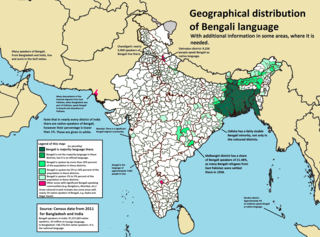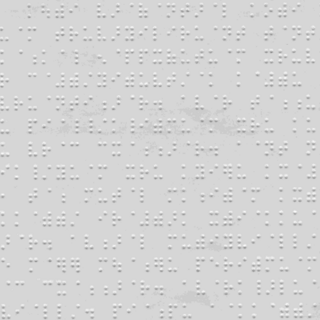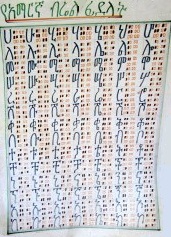
The Brahmic scripts, also known as Indic scripts, are a family of abugida writing systems. They are used throughout the Indian subcontinent, Southeast Asia and parts of East Asia. They are descended from the Brahmi script of ancient India and are used by various languages in several language families in South, East and Southeast Asia: Indo-Aryan, Dravidian, Tibeto-Burman, Mongolic, Austroasiatic, Austronesian, and Tai. They were also the source of the dictionary order (gojūon) of Japanese kana.

Bengali, generally known by its endonym Bangla, is an Indo-Aryan language native to the Bengal region of South Asia. With approximately 234 million native speakers and another 39 million as second language speakers as of 2017, Bengali is the sixth most spoken native language and the seventh most spoken language by the total number of speakers in the world. Bengali is the fifth most spoken Indo-European language.

Russian Braille is the braille alphabet of the Russian language. With suitable extensions, it is used for languages of neighboring countries that are written in Cyrillic in print, such as Ukrainian and Mongolian. It is based on the Latin transliteration of Cyrillic, with additional letters assigned idiosyncratically. In Russian, it is known as the Braille Script.

Bharati braille, or Bharatiya Braille, is a largely unified braille script for writing the languages of India. When India gained independence, eleven braille scripts were in use, in different parts of the country and for different languages. By 1951, a single national standard had been settled on, Bharati braille, which has since been adopted by Sri Lanka, Nepal, and Bangladesh. There are slight differences in the orthographies for Nepali in India and Nepal, and for Tamil in India and Sri Lanka. There are significant differences in Bengali Braille between India and Bangladesh, with several letters differing. Pakistan has not adopted Bharati braille, so the Urdu Braille of Pakistan is an entirely different alphabet than the Urdu Braille of India, with their commonalities largely due to their common inheritance from English or International Braille. Sinhala Braille largely conforms to other Bharati, but differs significantly toward the end of the alphabet, and is covered in its own article.
Greek Braille is the braille alphabet of the Greek language. It is based on international braille conventions, generally corresponding to Latin transliteration. In Greek, it is known as Κώδικας Μπράιγ Kôdikas Brég "Braille Code".
The goal of braille uniformity is to unify the braille alphabets of the world as much as possible, so that literacy in one braille alphabet readily transfers to another. Unification was first achieved by a convention of the International Congress on Work for the Blind in 1878, where it was decided to replace the mutually incompatible national conventions of the time with the French values of the basic Latin alphabet, both for languages that use Latin-based alphabets and, through their Latin equivalents, for languages that use other scripts. However, the unification did not address letters beyond these 26, leaving French and German Braille partially incompatible and as braille spread to new languages with new needs, national conventions again became disparate. A second round of unification was undertaken under the auspices of UNESCO in 1951, setting the foundation for international braille usage today.

Tamil Braille is the smallest of the Bharati braille alphabets.
Urdu Braille is the braille alphabet used for Urdu. There are two standard braille alphabets for Urdu, one in Pakistan and the other in India. The Pakistani alphabet is based on Persian Braille and is in use throughout the country, while the Indian alphabet is based on national Bharati Braille.
Telugu Braille is one of the Bharati braille alphabets, and it largely conforms to the letter values of the other Bharati alphabets.
Punjabi Braille is the braille alphabet used in India for Punjabi. It is one of the Bharati braille alphabets, and largely conforms to the letter values of the other Bharati alphabets.
Gujarati Braille is one of the Bharati braille alphabets, and it largely conforms to the letter values of the other Bharati alphabets.
Odia Braille is one of the Bharati braille alphabets. Apart from using Hindi æ for Odia ẏ, it conforms to the letter values of the other Bharati scripts.
Kannada Braille is one of the Bharati braille alphabets, and it largely conforms to the letter values of the other Bharati alphabets.
Malayalam Braille is one of the Bharati braille alphabets, and it largely conforms to the letter values of the other Bharati alphabets.
Sinhala Braille is one of the many Bharati braille alphabets. While it largely conforms to the letter values of other Bharati alphabets, it diverges in the values of the letters assigned toward the end of those alphabets.
Similar braille conventions are used for three languages of India and Nepal that in print are written in Devanagari script: Hindi, Marathi, and Nepali. These are part of a family of related braille alphabets known as Bharati Braille. There are apparently some differences between the Nepali braille alphabet of India and that of Nepal.

Ge'ez Braille is the braille alphabet for all Ethiopic languages. Letter values are mostly in line with international usage.
Dzongkha Braille or Bhutanese Braille, is the braille alphabet for writing Dzongkha, the national language of Bhutan. It is based on English braille, with some extensions from international usage. As in print, the vowel a is not written.
Several braille alphabets are used in Ghana. For English, Unified English Braille has been adopted. Four other languages have been written in braille: Akan (Twi), Ga, Ewe, and Dagaare. All three alphabets are based on the basic braille letter values of basic Latin alphabet:
Khmer Braille is the braille alphabet of the Khmer language of Cambodia.




